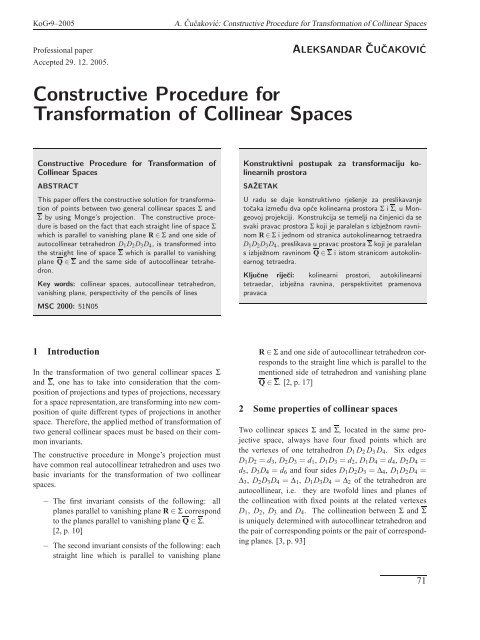Ovaj broj KoG-a u Adobe PDF formatu - hdgg
Ovaj broj KoG-a u Adobe PDF formatu - hdgg
Ovaj broj KoG-a u Adobe PDF formatu - hdgg
Create successful ePaper yourself
Turn your PDF publications into a flip-book with our unique Google optimized e-Paper software.
<strong>KoG</strong> •9–2005 A. Čučaković: Constructive Procedure for Transformation of Collinear Spaces<br />
Professional paper<br />
Accepted 29. 12. 2005.<br />
Constructive Procedure for<br />
Transformation of Collinear Spaces<br />
Constructive Procedure for Transformation of<br />
Collinear Spaces<br />
ABSTRACT<br />
This paper offers the constructive solution for transformation<br />
of points between two general collinear spaces Σ and<br />
Σ by using Monge’s projection. The constructive procedure<br />
is based on the fact that each straight line of space Σ<br />
which is parallel to vanishing plane R ∈ Σ and one side of<br />
autocollinear tetrahedron D1D2D3D4, is transformed into<br />
the straight line of space Σ which is parallel to vanishing<br />
plane Q ∈ Σ and the same side of autocollinear tetrahedron.<br />
Key words: collinear spaces, autocollinear tetrahedron,<br />
vanishing plane, perspectivity of the pencils of lines<br />
MSC 2000: 51N05<br />
1 Introduction<br />
In the transformation of two general collinear spaces Σ<br />
and Σ, one has to take into consideration that the composition<br />
of projections and types of projections, necessary<br />
for a space representation, are transforming into new composition<br />
of quite different types of projections in another<br />
space. Therefore, the applied method of transformation of<br />
two general collinear spaces must be based on their common<br />
invariants.<br />
The constructive procedure in Monge’s projection must<br />
have common real autocollinear tetrahedron and uses two<br />
basic invariants for the transformation of two collinear<br />
spaces.<br />
− The first invariant consists of the following: all<br />
planes parallel to vanishing plane R ∈ Σ correspond<br />
to the planes parallel to vanishing plane Q ∈ Σ.<br />
[2, p. 10]<br />
− The second invariant consists of the following: each<br />
straight line which is parallel to vanishing plane<br />
ALEKSANDAR ČUČAKOVIĆ<br />
Konstruktivni postupak za transformaciju kolinearnih<br />
prostora<br />
SAˇZETAK<br />
U radu se daje konstruktivno rjeˇsenje za preslikavanje<br />
točaka izmed - u dva opće kolinearna prostora Σ i Σ, u Mongeovoj<br />
projekciji. Konstrukcija se temelji na činjenici da se<br />
svaki pravac prostora Σ koji je paralelan s izbjeˇznom ravninom<br />
R ∈ Σ i jednom od stranica autokolinearnog tetraedra<br />
D1D2D3D4, preslikava u pravac prostora Σ koji je paralelan<br />
s izbjeˇznom ravninom Q ∈ Σ i istom stranicom autokolinearnog<br />
tetraedra.<br />
Ključne riječi: kolinearni prostori, autokilinearni<br />
tetraedar, izbjeˇzna ravnina, perspektivitet pramenova<br />
pravaca<br />
R ∈ Σ and one side of autocollinear tetrahedron corresponds<br />
to the straight line which is parallel to the<br />
mentioned side of tetrahedron and vanishing plane<br />
Q ∈ Σ. [2, p. 17]<br />
2 Some properties of collinear spaces<br />
Two collinear spaces Σ and Σ, located in the same projective<br />
space, always have four fixed points which are<br />
the vertexes of one tetrahedron D1 D2 D3 D4. Six edges<br />
D1D2 = d3, D2D3 = d1, D1D3 = d2, D1D4 = d4, D2D4 =<br />
d5, D3D4 = d6 and four sides D1D2D3 = Δ4, D1D2D4 =<br />
Δ3, D2D3D4 = Δ1, D1D3D4 = Δ2 of the tetrahedron are<br />
autocollinear, i.e. they are twofold lines and planes of<br />
the collineation with fixed points at the related vertexes<br />
D1, D2, D3 and D4. The collineation between Σ and Σ<br />
is uniquely determined with autocollinear tetrahedron and<br />
the pair of corresponding points or the pair of corresponding<br />
planes. [3, p. 93]<br />
71


